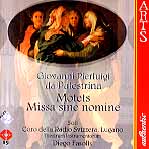It would be difficult for first-rate performers to diminish the glory of Palestrina’s music, whether it’s cast with one singer to a part or several, whether it’s presented in a church or an auditorium or a studio, or whether it’s performed a cappella or accompanied by instruments. And we get elements of all of these on this very fine recording from the Soloists and Choir of the Swiss Radio in Lugano, Switzerland. The singing is really gorgeous–these voices are lovely and well-tuned, with round, clear tone, pleasingly bright sopranos, and rich, full-bodied basses. And the balances are impressive, whether the configuration is four solo voices or a larger ensemble with instruments. And speaking of instruments, yes, more than half of the works are accompanied either by organ and continuo strings or by a larger contingent of instruments. Indeed, this rendition of the motet Tribulatione civitatum takes on a magnificent, Gabrieli-like heft and power owing to the addition of brass and organ. No explanation is given for the instrumental additions, but overall, the effect simply gives the sound more body and texture and complements the voices without distracting–and I have to admit that the just-mentioned motet is pretty exciting in this form.
The Missa sine nomine, which is nearly non-existent on disc, is performed here by four solo voices who handily manage matters of phrasing and textual explication while never forgetting to indulge the music’s expressive opportunities–an emphatic inflection here, a subtle accent there, a carefully rising and falling dynamic, ending with a perfectly tuned harmony that’s never over-extended. The bass opening to the Agnus Dei is really special, not only for its unusually low-lying line but for Daniele Carnovich’s especially sensitive delivery as he leads the other voices in. The singing here and in the other a cappella works (which use various combinations of singers) shows a cohesive ensemble, not only regarding interpretation but also in awareness of how to adjust balance and blend according to which voices are present. This group and its excellent conductor Diego Fasolis have made many fine recordings: add this one to the list. The sound, from several different locations over a period of several years, is surprisingly consistent. And it’s consistently very good. [9/8/2004]
































